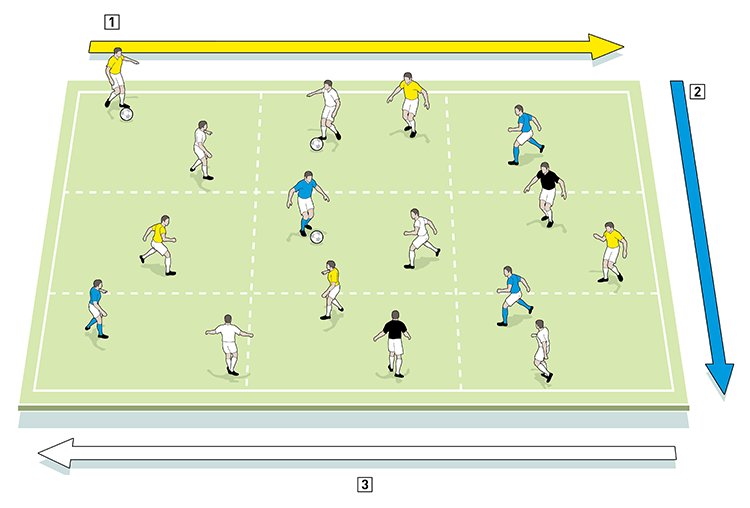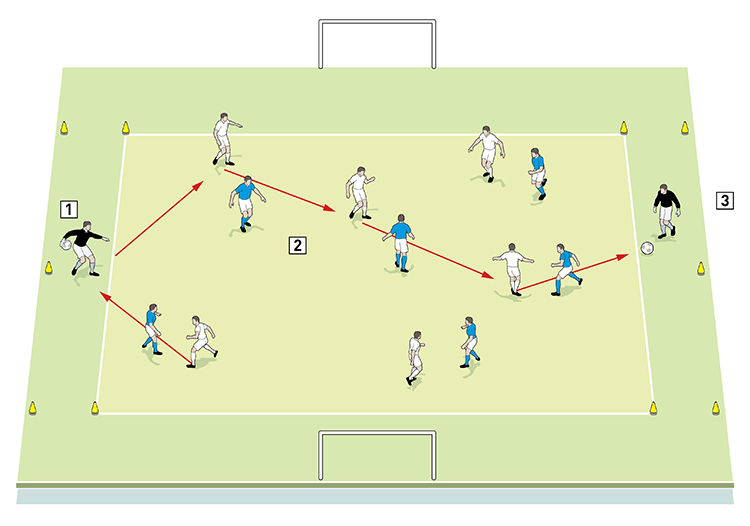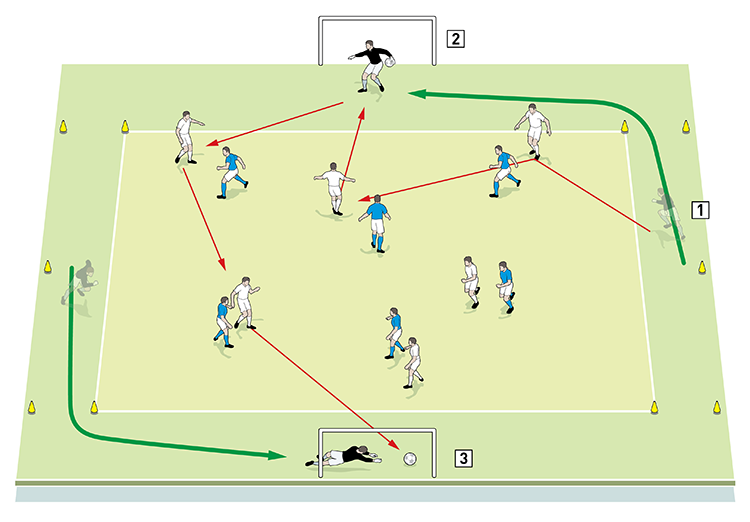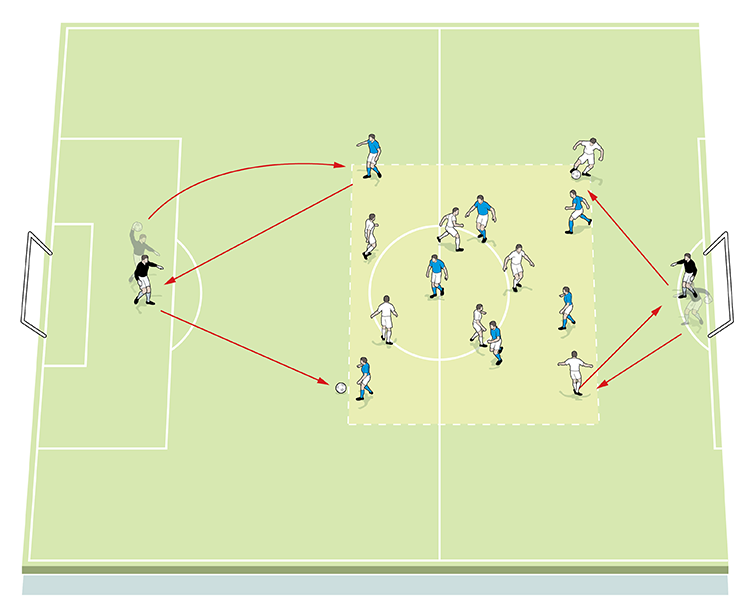




OUR BEST EVER OFFER - SAVE £100/$100
JOIN THE WORLD'S LEADING PROFESSIONAL DEVELOPMENT PROGRAMME
- 12 months membership of Elite Soccer
- Print copy of Elite Player & Coach Development
- Print copy of The Training Ground
You are viewing 1 of your 1 free articles
The eleventh man
Here are a collection of uni-directional games that test a number of developmental characteristics in players, from the technical to tactical.
| Area | Use of a full pitch |
| Equipment | Balls, cones, goals |
| No. of Players | Up to 16 |
| Session Time | 70mins |
Here are a collection of uni-directional games that test a number of developmental characteristics in players, from the technical (multiple and varied touches and passes of the ball, position-specific work and handling pressure), to tactical (linking with players in similar positions and game understanding linked to rules and conditions).
The session also embraces physical and psychological properties, and acts as a vital grounding for coaches who believe in the logic of using simple exercises to stimulate learning and confidence that can be played out in a in much ‘bigger’ match situations.
What do I get the players to do?
One-directional games
In possession – progress and penetrate (20mins)
To set up as shown (1) with three teams working (two include a keeper who will be interchanged between teams) and there is one ball per team.
For the task to begin, one player must exit the area with the ball. This is the trigger for him to turn, then work the ball across the area to see it exit at the opposite side, with yellows, blues and whites each given instructions as to whether to play horizontally or vertically.
We will set a time limit or instruct a number of passes with the intention of keeping the parameters fluid. This is achieved by the fact that teams have different player numbers. Two of these teams allow a keeper to be involved, who approaches and passes the ball in different ways to team mates.
1

2. Blues work the ball vertically (here, it’s top to bottom)
3. Whites have to move play horizontally (here, it’s right to left)
What are the key things to look out for?
We want to see the keeper’s technical work. He can instruct players as to whether he wants the ball fed to his hands or feet, and we can progress this as the session moves forward by varying the supply into the keeper and his instructed delivery back to team mates – he might be told to throw on the full, to miss out an area or to play with a side volley.
There should be outfield players present in each zone, and we can offer individual challenges to players as they anticipate receiving the ball. We also want to see transitions with a new ball being sent in (who can react first?), with position-specific passing and offsides being used.
Game 2 (20mins)
Now we move the first game on a level by setting up as shown (2a).
2a

2. Following the same principles as the first game, the ball is passed across to the other side
3. The keeper at the other end receives
The team in possession must attempt to visit each keeper (in their end zone, using their feet) in order to score a point. Once this has been done the keepers get into each goal straight away, with outfield players then looking to revisit one keeper (the choice being theirs) and score past the other (2b). If successful, keepers return to the end zone and the process restarts.
Extra challenges include the use of the offside line and an allowance for players to enter the keeper zone.
2b

2. The team in possession ‘revisit’ the top keeper
3. This determines that the goal attack must be towards the bottom goal
Goal protection
We now set up as shown (3a) with two teams operating in a 2-3-2 formation (replicating two centre-halves, three midfielders and two centre-forwards). There is a keeper in each goal – both begin by simultaneously playing out to a defender, receiving back and playing to the other side.
3a

Each team then works the ball through their three units (unopposed), before breaking the line with a pass for a player to run through on goal and score (3b).
3b

To progress this game players will swap the ends being attacked. We can also allow the two defenders to defend once they have distributed the ball, as well as engaging a recovering defender or supporting attacker. Further progressions include limiting the number of touches and playing fully opposed with just one ball.
If needed, we can introduce a points system as well – one point for breaking through (pass or run), two points for a goal in under six seconds, and three points for a goal in under three seconds.
What are the key things to look out for?
In this practice we’re looking at the keeper’s detail of pass, support options and ability to defend the spaces in front of him. We want to see defenders’ receiving skills and body shape to play forward, good midfield play (positioning, support, rotating, receiving), and similar for strikers (timing of runs, finishing skills).
Related Files
Editor's Picks
Attacking transitions
Deep runs in the final third
Using the goalkeeper in build-up play
Intensive boxes drill with goals
Penetrating the final third
Creating and finishing
My philosophy
Pressing initiation
Compact team movement
Coaches' Testimonials

Alan Pardew

Arsène Wenger

Brendan Rodgers

Carlos Carvalhal

José Mourinho

Jürgen Klopp

Pep Guardiola

Roy Hodgson

Sir Alex Ferguson

Steven Gerrard
Coaches' Testimonials

Gerald Kearney, Downtown Las Vegas Soccer Club

Paul Butler, Florida, USA

Rick Shields, Springboro, USA

Tony Green, Pierrefonds Titans, Quebec, Canada
Join the world's leading coaches and managers and discover for yourself one of the best kept secrets in coaching. No other training tool on the planet is written or read by the calibre of names you’ll find in Elite Soccer.
In a recent survey 92% of subscribers said Elite Soccer makes them more confident, 89% said it makes them a more effective coach and 91% said it makes them more inspired.
Get Monthly Inspiration
All the latest techniques and approaches
Since 2010 Elite Soccer has given subscribers exclusive insight into the training ground practices of the world’s best coaches. Published in partnership with the League Managers Association we have unparalleled access to the leading lights in the English leagues, as well as a host of international managers.
Elite Soccer exclusively features sessions written by the coaches themselves. There are no observed sessions and no sessions “in the style of”, just first-hand advice delivered direct to you from the coach.







